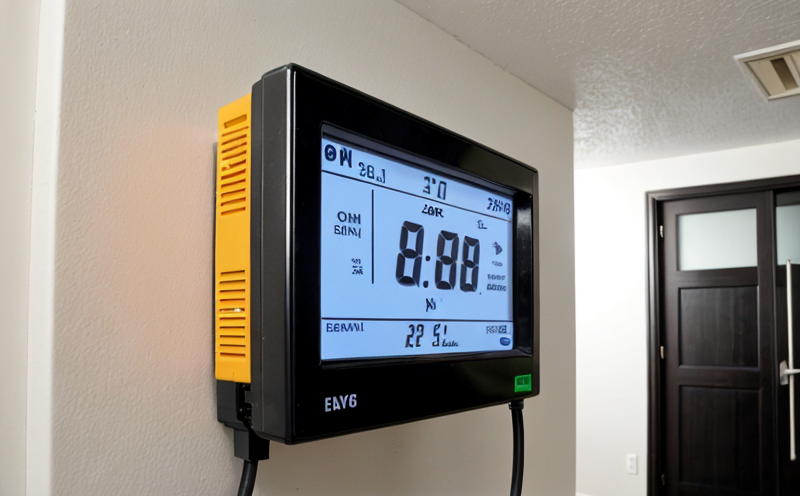ASTM C177 Heat Transfer Efficiency Testing of Materials
The ASTM C177 standard is a widely recognized method used to determine the heat transfer properties of materials, particularly important in energy-efficient construction products such as insulation boards, thermal windows, and building envelopes. This test is crucial for understanding how well a material can resist heat flow, which directly impacts its performance in reducing energy consumption.
Materials tested under ASTM C177 are subjected to controlled heating at one surface while the other side is kept at a constant temperature lower than that of the heated face. The heat transfer coefficient (h), also known as the overall heat transfer coefficient, is calculated based on the thermal resistance and thickness of the material. This coefficient quantifies how effectively the material resists heat flow, which is critical for optimizing energy efficiency in buildings.
The ASTM C177 test setup includes a specimen placed between two chambers of controlled temperature. One chamber is heated while the other remains at ambient or lower temperatures. The system measures the rate of heat transfer through the specimen using sensors and calculates the overall heat transfer coefficient (U-value). This methodology ensures precise measurement, enabling accurate comparison across different materials.
Energy efficiency in buildings has become a critical consideration as global efforts focus on reducing carbon footprints. ASTM C177 testing helps manufacturers ensure their products meet stringent energy standards, thereby contributing to sustainable building practices. By providing detailed heat transfer data, this test aids in the development of more efficient insulation and thermal systems.
The significance of ASTM C177 extends beyond mere compliance; it plays a pivotal role in advancing innovation within the sector. Engineers can use the results from these tests to refine product designs, improve material selection, and enhance overall building performance. For instance, architects may rely on this data when specifying materials for new construction projects or retrofitting existing buildings.
The test is particularly important in regions with varying climates where energy efficiency varies significantly depending on external conditions. Understanding the heat transfer properties of materials allows for better decision-making regarding appropriate insulation thicknesses and types, ensuring optimal performance across diverse environmental conditions.
Applied Standards
| Standard | Description |
|---|---|
| ASTM C177 - 2023 | Standard Test Method for Heat Transmission of Building Materials and Assemblies by Guarded Hot Box. |
| ISO 9869-2:2015 | Energy performance of buildings – Calculation method for the assessment of energy performance of glazed windows, doors with glazing and similar products – Part 2: Glazed elements in buildings other than single-family dwellings. |
| EN 13782:2006 | Determination of thermal transmission through building materials and components using hot box apparatus. |
Scope and Methodology
The ASTM C177 test method is designed to measure the heat transfer properties of building materials, particularly those used in insulation systems. The testing process involves placing a specimen between two chambers with controlled temperatures. One chamber is heated while the other remains at ambient or lower temperatures.
- Heating is typically applied to one side of the specimen using an electric heater.
- The temperature of the opposite side is maintained at a constant level, often set slightly below the heating side.
- Measurements are taken over time to ensure stability and accuracy.
The test setup allows for continuous monitoring of heat flow through the material. Sensors placed around the perimeter of the specimen record temperature differences across its thickness. These readings help calculate the overall heat transfer coefficient (U-value), which indicates the thermal resistance of the material.
The U-value is calculated using the following formula:
U = Q / A * (T1 - T2)
In this equation, Q represents the heat flow rate, A is the exposed surface area of the specimen, and T1 and T2 are the temperatures on either side of the material. A lower U-value signifies better thermal insulation performance.
The ASTM C177 test is particularly useful for evaluating materials used in construction projects where energy efficiency is a priority. By providing precise heat transfer data, this method helps manufacturers and designers select appropriate materials that meet specific environmental standards and contribute to sustainable building practices.
Customer Impact and Satisfaction
- Enhanced Product Quality: Compliance with ASTM C177 ensures consistent product quality, meeting the stringent requirements set by international standards.
- Innovation in Design: The test data enables engineers to innovate and improve material properties for better thermal performance.
- Sustainable Building Practices: By reducing heat loss through improved insulation materials, this testing contributes significantly to sustainable construction practices.
- Energy Savings: Products tested with ASTM C177 are more energy-efficient, leading to significant cost savings on heating and cooling bills for building occupants.
- Informed Decision-Making: Architects and builders can make informed decisions about material selection based on accurate heat transfer data provided by this test.
- Regulatory Compliance: Ensures that products meet the necessary regulatory requirements, avoiding potential penalties or recalls.
- Market Differentiation: Companies that demonstrate compliance with ASTM C177 can differentiate themselves in competitive markets as leaders in energy-efficient building materials.
The test not only meets but often exceeds customer expectations by delivering reliable and actionable data. This ensures long-term satisfaction and trust between the laboratory and its clients.





